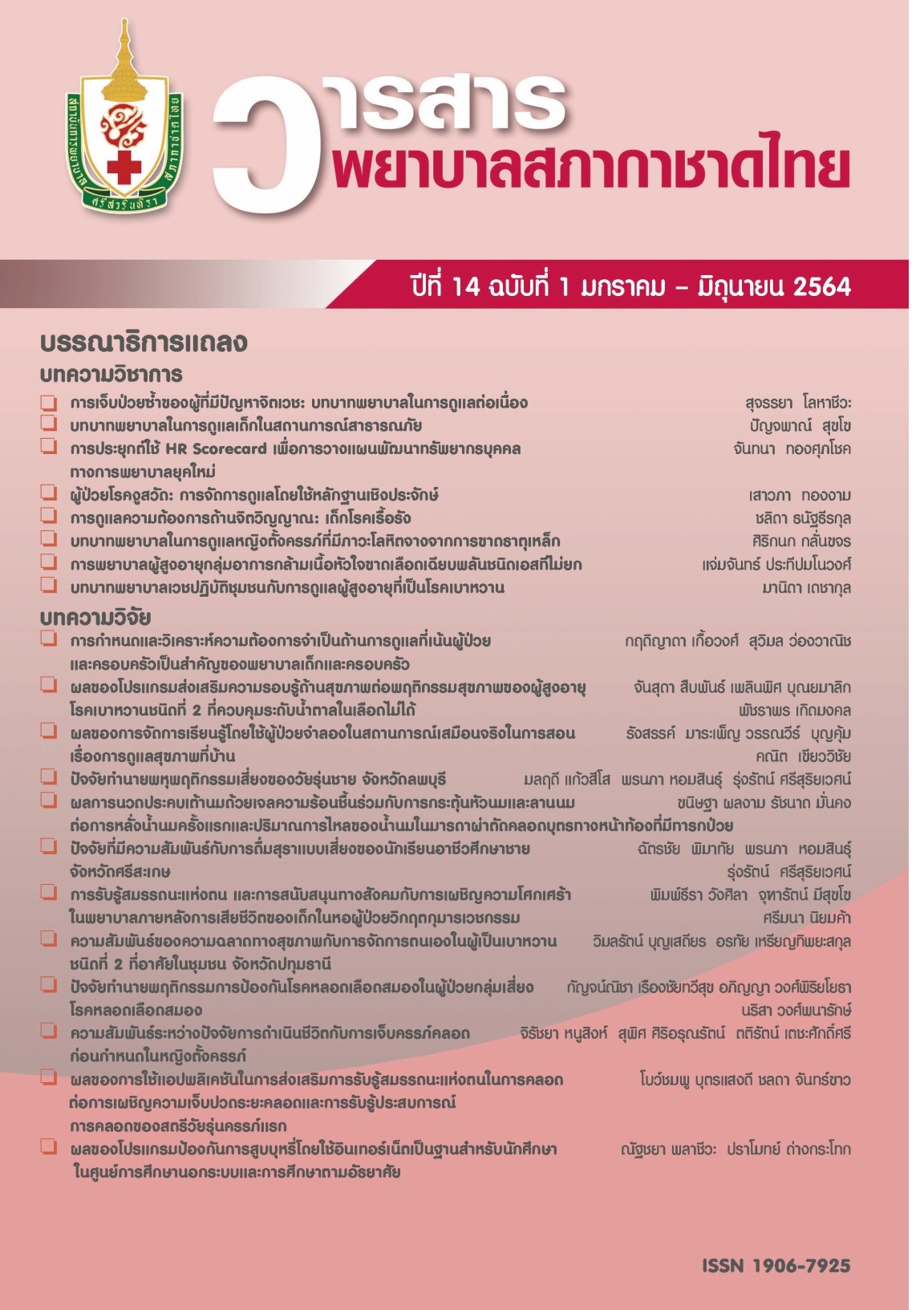Effects of an Internet-Based Smoking Prevention Program on Students with Non-Formal and Informal Education
Abstract
The objective of this research was to study effects of an internet-based smoking prevention program on students with non-formal and informal education. This was an experimental study, with two-group repeated measurements, immediate post-test and three months follow up. The 32 participants, students with non-formal and informal education, were divided equally into the experimental group that received an internet-based smoking prevention program, and the control group, which received the usual learning program. Data were collected using; 1) Knowledge Regarding Smoking, 2) Attitudes toward Smoking, 3) Decision Making in Smoking Refusal, 4) Smoking Refusal Skill, and 5) Self-efficacy in Smoking Refusal. Data were analyzed using descriptive statistics and Repeated Measures ANOVA
Results reveal that among the members of the experimental group, there were significant increases in the mean scores of knowledge regarding smoking and self-efficacy in smoking refusal at baseline, immediate post-test and three months follow up (p < .05). Also, there were significant differences in the mean scores of knowledge regarding smoking and self-efficacy in smoking refusal at baseline, immediate post-test and three months follow up between experiment and control group (p < .05).
Community nurses or teachers can integrate this program into health promotion programs or Health education courses to improve knowledge regarding smoking and self-efficacy for smoking prevention among students with non-formal and informal education.
References
2. Suvamat J, Thiammok M. The review of activities on smoking prevention for adolescents. Journal of Boromarajonani College of Nursing, Bangkok 2018;34(1):141-9. (in Thai)
3. Thangkratok P, Chaimo E, Yingyoud P, Trainattawan W. Prevalence of tobacco smoking among nursing students: a systematic review. Journal of Health Science 2019;28(4):601-9. (in Thai)
4. National Center for Chronic Disease Prevention and Health Promotion (U.S.) Office on Smoking and Health. Preventing tobacco use among youth and young adults: a report of the Surgeon General. Atlanta, GA: Centers for Disease Control and Prevention (US); 2012.
5. Pichai P, Rungchamrus J. Alternative approaches to development of a program for smoking cessation among adolescents. Journal of Humanities and Social Sciences Thonburi University 2015;9(19):158-69. (in Thai)
6. Santano-Mogena E, Franco-Antonio C, Chimento-Díaz S, Rico-Martín S, Cordovilla-Guardia S. Factors associated with smoking susceptibility among high school students in western Spain. Sci Rep 2021;11(1):1988. https://doi.org/10.1038/s41598-021-81723-5
7. Gwaltney CJ, Metrik J, Kahler CW, Shiffman S. Self-efficacy and smoking cessation: a meta-analysis. Psychol Addict Behav 2009;23(1):56-66.
8. Bandura A. Self-efficacy: the exercise of control. New York: W.H. Freeman; 1997.
9. Elshatarat RA, Yacoub MI, Khraim FM, Saleh ZT, Afaneh TR. Self-efficacy in treating tobacco use: a review article. Proceedings of Singapore Healthcare 2016;25(4):243-8.
10. Janz NK, Becker MH. The health belief model: a decade later. Health Educ Q 1984;11(1):1-47.
11. Fishbein M, Ajzen I, Flanders NA. Belief, attitude, intention, and behavior: an introduction to theory and research. Massachusetts: Addison-Wesley; 1975.
12. Bandura A. Self-efficacy: toward a unifying theory of behavioral change. Psychol Rev 1977;84(2):191-215.
13. Palacheewa N, Thangkratok P. Digital technology: innovation for smoking prevention among children and adolescents in the twenty-first century. Thai Journal of Cardio-Thoracic Nursing 2019;30(2):15-25. (in Thai)
14. Palacheewa N, Tiansawad S, Srisuphan W, Whattananarong K, Duffy SA. Development of an internet-based smoking prevention program for young male adolescents in Thailand. Pacific Rim Int J Nurs Res 2014;18(3):228-43. (in Thai)
15. Hwang MS, Yeagley KL, Petosa R. A meta-analysis of adolescent psychosocial smoking prevention programs published between 1978 and 1997 in the United States. Health Educ Behav 2004;31(6):702-19.
16. Jantachum W. Development of smoking-prevention strategies among students through participation process: a case study of an expansion school in Kalasin Province. Journal of Behavioral Science 2006:23(1);94-109. (in Thai)
17. Homsin P. Concepts and theories for practice: smoking and alcohol drinking prevention among adolescents. Chonburi: Faculty of Nursing Burapha University; 2015. (in Thai)
18. Ongiem A, Vichitvejpaisal P. Validation of the tests. Thai J Anesthesiol 2018;44(1):36-42. (in Thai)
19. Taber KS. The use of Cronbach’s alpha when developing and reporting research instruments in acience education. Res Sci Educ 2018;48(6):1273-96.
20. Park E, Drake E. Systematic review: internet-based program for youth smoking prevention and cessation. J Nurs Scholarshi 2015;47(1):43-50.
Downloads
Published
Issue
Section
License
เนื้อหาบทความหรือข้อคิดเห็นต่างๆ ในวารสารพยาบาลสภากาชาดไทยนี้ เป็นความคิดเห็นของผู้เขียนบทความ ไม่ใช่ความเห็นของกองบรรณาธิการ หรือสถาบันการพยาบาลศรีสวรินทิรา สภากาชาดไทย






